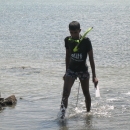Grants :: Small Grant Facilities :: Studying seagrasses in Puttalam lagoon
Studying seagrasses in Puttalam lagoon
Objectives
Studying the species diversity, species abundance and distribution of seagrasses in the Puttalam lagoon.
Background
Seagrasses are seed-bearing, flowering, rooted plants, which grow underwater, exclusively in coastal marine waters and coastal brackish water wetlands. Like grasses in terrestrial habitats, they form meadows on the beds of shallow coastal seas, estuaries and lagoons. They depend on light for photosynthesis and therefore, they generally grow only in clear, shallow waters, in estuaries and coastal seas. They cannot survive out of water.
Seagrass meadows form ecologically and economically important habitats because they provide many ecosystem services. For example, many edible fish are found living in seagrass meadows, which provide feeding, breeding and nursery grounds for many finfish and shellfish.
Because of this, seagrasses are critical in coastal productivity and fisheries. Seagrass meadows act as filters for coastal waters; and they stabilise the floor of coastal seas. Because seagrass meadows are three-dimensional in structure, they provide shelter for, and house, thousands of other species – micro-organisms, algae, invertebrates and vertebrates. Seagrasses cycle nutrients in coastal waters and are carbon sinks. Seagrasses are called ‘biological sentinels’ because they respond quickly to changes in water quality, indicating deterioration of the surrounding environment by degrading and declining, before dying.
Fifteen species of seagrasses have been recorded in Sri Lanka. There may be more species, but there is a paucity of information about the distribution and species composition of seagrass communities in Sri Lanka. Partly because of the security situation that prevailed in the northwest – where seagrasses are abundant – and partly because of the need for specialised swimming, diving and snorkelling skills for studying seagrasses, there has not been sufficient research carried out in the area. Studies on the diversity and distribution of seagrasses in Sri Lanka, are, therefore important.
Target beneficiaries
Researchers and planners.
Outputs
Eight different seagrass species were observed in the Puttalam Lagoon during the study. These are Cymodocea rotundata, C.serrulata, Enhalus acoroides, Thalassia hemprichii, Halodule uninervis, Syringodium isoetifolium, Halophila ovalis and H. decipiens.
Herbarium sheets of these species are being prepared for the National Herbarium.
A map of the distribution of seagrasses in the Puttalam Lagoon has been prepared and was given to relevant government agencies.
Accomplishments and challenges
- This study is contributing to the ongoing process of national Red Listing.
- These data have already been made available to scientists working in the field of Marine Biology.
Contributions to cross-cutting themes
Knowledge generated has been shared widely.
Lessons Learned
- The absence of an appropriate common forum in Sri Lanka for scientists working in the field is a major deficiency.
- The understanding of sea-grass beds in terms of economic and ecological values is poor, and is a barrier to its use in livelihoods.
Project Facts
Country
Location
Puttalam lagoon, Puttalam
Topic
Duration
1st May 2011 to 30th Apr 2012
MFF Grant Amount
LKR 587,000.00
Co-financing Partner
Grantee: LKR 500,500
Community: LKR 50,000
Implementing Partner
Dr Terney Pradeep KumamaHead Dept of Oceanography and Marine GeologyFaculty of fisheries and Marine Sciences and TechnologyUniv. Of RuhunaMataraTel: + 94 41-2222681terney@fish.ruh.ac.lk"The findings will be shared with relevant government agencies" Dr T. P. Kumara.
